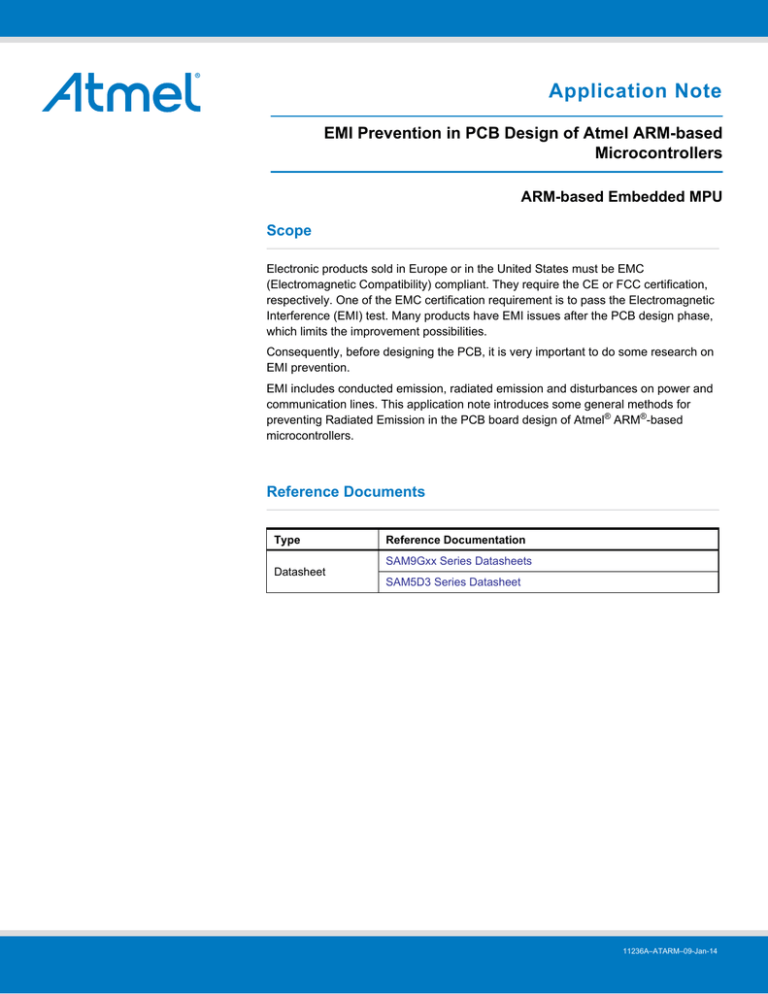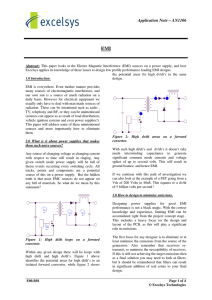
Application Note
EMI Prevention in PCB Design of Atmel ARM-based
Microcontrollers
ARM-based Embedded MPU
Scope
Electronic products sold in Europe or in the United States must be EMC
(Electromagnetic Compatibility) compliant. They require the CE or FCC certification,
respectively. One of the EMC certification requirement is to pass the Electromagnetic
Interference (EMI) test. Many products have EMI issues after the PCB design phase,
which limits the improvement possibilities.
Consequently, before designing the PCB, it is very important to do some research on
EMI prevention.
EMI includes conducted emission, radiated emission and disturbances on power and
communication lines. This application note introduces some general methods for
preventing Radiated Emission in the PCB board design of Atmel® ARM®-based
microcontrollers.
Reference Documents
Type
Reference Documentation
SAM9Gxx Series Datasheets
Datasheet
SAM5D3 Series Datasheet
11236A–ATARM–09-Jan-14
Table of Contents
Scope . . . . . . . . . . . . . . . . . . . . . . . . . . . . . . . . . . . . . . . . . . . . . . . . . . . . 1
Reference Documents . . . . . . . . . . . . . . . . . . . . . . . . . . . . . . . . . . . . . . . 1
Table of Contents . . . . . . . . . . . . . . . . . . . . . . . . . . . . . . . . . . . . . . . . . . . 2
1. EMI Fundamentals . . . . . . . . . . . . . . . . . . . . . . . . . . . . . . . . . . . . . . . 3
1.1
1.2
1.3
EMI Concept . . . . . . . . . . . . . . . . . . . . . . . . . . . . . . . . . . . . . . . . . . . . . . . . . . . 3
SI and Transmission Lines . . . . . . . . . . . . . . . . . . . . . . . . . . . . . . . . . . . . . . . . 3
CE/FCC Radiated Emission Test Method. . . . . . . . . . . . . . . . . . . . . . . . . . . . . 5
2. General EMI Prevention Methods . . . . . . . . . . . . . . . . . . . . . . . . . . . 5
2.1
2.2
2.3
PCB Layout Recommendations . . . . . . . . . . . . . . . . . . . . . . . . . . . . . . . . . . . . 5
Board Simulation Using IBIS Model . . . . . . . . . . . . . . . . . . . . . . . . . . . . . . . . . 8
EMI Suppression Components . . . . . . . . . . . . . . . . . . . . . . . . . . . . . . . . . . . . . 9
3. Parallel IO Drive Impedance in Atmel ARM-based Microcontrollers 11
3.1
3.2
PIO Drive Capability Adjustment. . . . . . . . . . . . . . . . . . . . . . . . . . . . . . . . . . . 11
DDR2 Signals in Atmel ARM-based Microcontrollers . . . . . . . . . . . . . . . . . . . 12
4. Conclusion . . . . . . . . . . . . . . . . . . . . . . . . . . . . . . . . . . . . . . . . . . . . 13
5. Revision History . . . . . . . . . . . . . . . . . . . . . . . . . . . . . . . . . . . . . . . . 14
EMI Prevention in PCB Design of Atmel ARM-based Microcontrollers [APPLICATION NOTE]
11236A–ATARM–09-Jan-14
2
1.
EMI Fundamentals
1.1
EMI Concept
EMC (Electromagnetic Compatibility) mainly consists of EMI (Electromagnetic Interference) and EMS (Electromagnetic
Susceptibility).
EMI includes conducted emission and radiated emission, as shown in Figure 1-1.
Figure 1-1.
1.2
EMI Model
SI and Transmission Lines
Signal integrity (SI) and transmission lines have an impact on EMI.
1.2.1
SI
Ensuring a good Signal Integrity across a transmission medium (cable, PCB trace..) means being able to transmit the
signal without altering its content. In particular, for digital signals, this means to have:
clean and fast transitions
stable and correct logic levels
precise placement in time
Signal integrity problems increase with fast transients, which are directly linked with high-frequency switching signals.
Throughout this document, the term "high frequency" will be used to refer to these fast transients, and not to the
frequency of the signal itself (e.g. a 100-kHz signal with sub-nanoseconds edges may create EMI issues in a system).
1.2.2
Transmission Line
At low frequencies, a metal trace may be considered as a simple resistor.
When the frequency increases, the trace starts to act like a capacitor. At highest frequencies, the trace inductance plays
an important role. the inductance of the trace plays a significant role.
At high frequencies, components and PCB traces are no longer ideal. They have parasitic parameters and the traces
behave as transmission lines, as shown in Figure 1-2.
EMI Prevention in PCB Design of Atmel ARM-based Microcontrollers [APPLICATION NOTE]
11236A–ATARM–09-Jan-14
3
Figure 1-2. Transmission Line Model
The diagram on the left illustrates the real model of a trace (RLGC wire representation). In this diagram:
R + Ls 1 ⁄ 2
Z 0 = ⎛ -----------------⎞
⎝ G + Cs⎠
The diagram on the right is the first-order approximation model for an ideal transmission line (First order approximation
wire representation). In this diagram:
L 1⁄2
Z 0 = ⎛ ----⎞
⎝ C⎠
The impedance ZO (known as "intrinsic impedance") of the transmission line is a key parameter to achieve a good level
of signal integrity.
1.2.3
EMI Caused by Impedance Mismatch
Impedance mismatch may cause EMI problems.
There are two main types of impedance mismatch on a transmission line:
The transmitter output impedance (ZS) does not match the line impedance (ZO)
Reflection coefficient: (ZS - ZO) / (ZS+ZO)
The receiver or load impedance (ZL) does not match the line impedance (ZO)
Reflection coefficient: (ZL - ZO) / (ZL+ZO)
For both mismatch types, the transmitted signal is not fully absorbed on the receiver side, and the excess energy is
reflected back in the opposite direction. The same reflection occurs on the transmitter side and then, the reflection
phenomenon bounces back and forth till the energy declines. This phenomenon is also called "ringing".
Any impedance mismatch along the transmission line produces signal reflection.
Figure 1-3.
Reflected Wave
An analysis of either the transmitter or the receiver side shows ringing, especially near the rising or falling edges, which
means that the signal has an SI issue. This ringing usually involves high-frequency components emitting radiation along
the current loop. This radiation causes EMI issues.
EMI Prevention in PCB Design of Atmel ARM-based Microcontrollers [APPLICATION NOTE]
11236A–ATARM–09-Jan-14
4
To decrease the reflection phenomenon, the line impedance (ZO) should match both the transmitter output impedance
(ZS) and the load impedance (ZL). Several methods are available to reduce this phenomenon, including the use of serial
termination or parallel termination.
1.3
CE/FCC Radiated Emission Test Method
For details on radiated emissions (30 MHz to 1G, >1G), please refer to the EN55022:2010 or CISPR 22 standards
(“Information technology equipment - Radio disturbance characteristics - Limits and methods of measurement”).
Table 1-1 and Table 1-2 list the radiated disturbance limits for frequency ranges from 30 MHz to 1 GHz.
Table 1-1.
Limits for Radiated Disturbance of Class A (Commercial) ITE at a Measuring Distance of 10 m
Quasi-peak limits in dB (μV/m)
30 to 230 MHz frequency range
40
230 to 1000 MHz frequency range
47
Notes: 1.
2.
Table 1-2.
The lower limit must apply at the transition frequency.
Additional provisions may be required for cases where interference occurs.
Limits for Radiated Disturbance of Class B (Industrial) ITE at a Measuring Distance of 10 m
Quasi-peak limits in dB (μV/m)
Notes: 1.
2.
30 to 230 MHz frequency range
30
230 to 1000 MHz frequency range
37
The lower limit must apply at the transition frequency.
Additional provisions may be required for cases where interference occurs.
2.
General EMI Prevention Methods
2.1
PCB Layout Recommendations
2.1.1
PCB Placement
For a good PCB placement, it is recommended to:
Assign different areas for different circuit types (power circuit, low-frequency digital circuit, high-frequency digital
circuit, analog circuit, etc).
Place the components so as to ensure short ground return paths: the ground current of noisy components should
be kept on a short path and placed away from sensitive components (analog circuits or clock generation circuits).
For example, a switching power supply component must be placed close to the input connector and not on the
opposite side of the board.
Systematically add a decoupling capacitor to power/ground pairs of integrated circuits. In addition to the large
capacitors (10 nF to 1 μF), it is highly recommended to use low-impedance decoupling capacitors (such as 100-pF
capacitors) at high frequencies.
Maintain a distance between the sensitive components (such as crystal and oscillator) and the other components
or disturbance signals.
EMI Prevention in PCB Design of Atmel ARM-based Microcontrollers [APPLICATION NOTE]
11236A–ATARM–09-Jan-14
5
2.1.2
Large GND Reference Plane
Some recommendations related to the GND reference plane are provided in the following list:
2.1.3
The PCB should include a large and unbroken ground plane. Ideally, one layer of the PCB should be totally filled
with ground.
As many vias as possible should be added to connect this ground plane to the ground islands on the other layers
of the board.
The separation between noisy and sensitive parts of the circuit must be performed by a good placement of the
components: as the current always flows in the least resistive/inductive path, an adequate placement of the
components can bias the ground-current path that each component follows and thus minimize the shared paths.
When this strategy is not possible or not effective enough, two distinct ground planes can be drawn and star
connected either with multiple vias or with ferrites. When adopting this strategy, designers must be aware that two
adjacent ground planes drawn on a single PCB layer and separated by a gap behave like a dipole antenna during
EMC tests.
PCB Routing
For high-speed signals, the trace length must be as short as possible, and the distance between the center of two
adjacent wires must be more than three times the wire width (called '3W rule') to prevent crosstalk.
In some applications (such as DDR data lines), wires require controlled lengths.
To achieve this, snake routing (1) can be used. In this case, the distance between the parallel sections of the bus must be
higher than 4H (H being the distance between the wire plane and the reference plane).
The following list provides some other guidelines:
2.1.4
Recommended procedures
Routing 45° corners
Shielding oscillator nets and pads with a ground ring.
Routing fast differential signals as close as possible to each other with identical trace lengths (e.g.
DDR/DDR2 clocks, USB bus).
Minimizing vias and layer changes on fast signals (route them first).
Procedures to avoid:
Routing 90° corners (this creates ringing and EMI).
Making unnecessary layer changes, especially on fast signals (route them first).
Having stubs, such as unconnected tracks. Also beware of disconnected jumpers and not populated
components. These stubs function as antennas and may create/receive EMI.
Implementing ground and power loops (when traces are used for VCC/GND connections).
Splitting the ground plane.
Routing high-speed signal over a slot in the ground plane (this creates EMI).
PCB Stack
For high-frequency boards, it is necessary to control the impedance. Consequently, the PCB stack must be adjusted to
meet the impedance matching requirements including: thickness of the metal and dielectric layer, wire width, etc.
Some software tools can be used to calculate the impedance. The parameters of the PCB can also be factory-adjusted to
meet the customer’s impedance matching requirements.
1.
Deliberately meandering a track to lengthen its path.
EMI Prevention in PCB Design of Atmel ARM-based Microcontrollers [APPLICATION NOTE]
11236A–ATARM–09-Jan-14
6
Figure 2-1.
Impedance Calculation Tool Output Example
EMI Prevention in PCB Design of Atmel ARM-based Microcontrollers [APPLICATION NOTE]
11236A–ATARM–09-Jan-14
7
2.2
Board Simulation Using IBIS Model
Many CAD tools are available to perform PCB simulations: Cadence's Spectra, Altium, Hyperlynx, etc.
Figure 2-2 shows the Hyperlynx simulation tool.
Figure 2-2. PCB trace simulation example
To perform the simulation, the following input is required:
PCB stacking details and related information
IBIS model of transmitters and receiver(s)
By setting the correct device frequency, and then running simulation, it is possible to get the signal wave and spectrum in
order to determine the prominent frequency rays.
EMI Prevention in PCB Design of Atmel ARM-based Microcontrollers [APPLICATION NOTE]
11236A–ATARM–09-Jan-14
8
2.3
EMI Suppression Components
Several components are available to reduce the EMI:
2.3.1
Decoupling capacitors or filter for VCC
Resistors or ferrite beads
Spread-spectrum oscillators
Decoupling Capacitor or Filter for VCC
When used on each active device, the bypass or decoupling capacitors must be connected to the power supply and be
as close as possible to the device.
An LC filter can also be added at the beginning of every power line branch for each high-current device, as shown in
Figure 2-3.
Figure 2-3.
2.3.2
LC Filtering scheme
Resistors or Ferrite Beads
Fast transients contain several frequency components. The number of high-frequency components is decreased by
limiting the slew rate of fast switching signals.
Resistors of ferrite beads can also be added in series with the signal trace to suppress some special frequency
components.
EMI Prevention in PCB Design of Atmel ARM-based Microcontrollers [APPLICATION NOTE]
11236A–ATARM–09-Jan-14
9
2.3.3
Spread-spectrum Oscillators
In some cases, the spread spectrum oscillators are used to replace quartz oscillators and help the board pass the EMI
tests without making any board changes. Figure 2-4 shows the spectrum difference between conventional clock and
spread-spectrum oscillator.
Figure 2-4.
Spectrum of Oscillator
Frequency
Conventional Oscillator
Frequency
Spread-Spectrum Oscillator
The following list provides some features of the “Sitime high-performance series sit9001” example:
Down spread type (-0.5%, -1%, -2%)
Center spread type (±0.25%, ±0.5%, ±1%)
Cycle-to-cycle jitter: 29 ps
Dramatic EMI reduction (up to -16 dB)
No need for crystal or load capacitors
In applications based on Atmel ARM-based microcontrollers, users can set the MPU in bypass mode (clock signal
directly input) when using this type of oscillator externally.
EMI Prevention in PCB Design of Atmel ARM-based Microcontrollers [APPLICATION NOTE]
11236A–ATARM–09-Jan-14
10
3.
Parallel IO Drive Impedance in Atmel ARM-based Microcontrollers
3.1
PIO Drive Capability Adjustment
The External Bus Interface (EBI) is designed to transfer data between several external devices and the embedded
Memory Controller in an ARM-based device.
The EBI I/O Drive can be configured by software: 0 = High drive (default), 1 = Low drive. Low drive reduces overshoots.
For other GPIOs or peripherals, three types of drive capabilities are usually available: Low Drive, Medium Drive and High
Drive.
More generally, using lower drive helps reduce SI problems at the expense of slower transients. Since steep transients
must often be avoided, a simple system analysis and a customized tuning of the drive of the different IOs can greatly
reduce SI problems.
The following PIO_DRIVER1 register description is extracted from the Atmel SAM9G15 datasheet.
PIO I/O Drive Register 1
Name:
PIO_DRIVER1
Address:
0xFFFFF514 (PIOA), 0xFFFFF714 (PIOB), 0xFFFFF914 (PIOC), 0xFFFFFB14 (PIOD)
Access:
Read-write
Reset:
0x0
31
30
29
LINE15
23
22
21
LINE11
15
27
14
20
13
19
6
25
12
18
11
5
17
4
10
3
9
8
LINE4
2
LINE1
16
LINE8
LINE5
LINE2
24
LINE12
LINE9
LINE6
LINE3
26
LINE13
LINE10
LINE7
7
28
LINE14
1
0
LINE0
• LINEx [x=0..15]: Drive of PIO Line x
Value
Name
Description
0
HI_DRIVE
High drive
1
ME_DRIVE
Medium drive
2
LO_DRIVE
Low drive
3
-
Reserved
EMI Prevention in PCB Design of Atmel ARM-based Microcontrollers [APPLICATION NOTE]
11236A–ATARM–09-Jan-14
11
3.2
DDR2 Signals in Atmel ARM-based Microcontrollers
In some Atmel ARM-based microcontrollers such as the SAMA5D3 series, the DDR2 controller has ODT (On-die
Termination), which can be used to make the device output impedance match the PCB trace’s impedance.
The output drive impedance value can be changed by programming “RDIV” in the “MPDDRC I/O Calibration Register”:
This value is given in the following table:
Table 3-1.
Output drive impedance table
Value
Name
Description
1
RZQ_34
2
RZQ_40_RZQ_33_3
3
RZQ_48_RZQ_40
LPDDR2:RZQ = 48 ohms, DDR2/LPDDR1: RZQ = 40 ohms
4
RZQ_60_RZQ_50
LPDDR2:RZQ = 60 ohms, DDR2/LPDDR1: RZQ = 50 ohms
6
RZQ_80_RZQ_66_7
LPDDR2: RZQ = 80 ohms, DDR2/LPDDR1: RZQ = 66.7 ohms
7
RZQ_120_RZQ_100
LPDDR2:RZQ = 120 ohms, DDR2/LPDDR1: RZQ = 100 ohms
LPDDR2 RZQ = 34.3 ohms, DDR2/LPDDR1: Not applicable
LPDDR2:RZQ = 40 ohms, DDR2/LPDDR1: RZQ = 33.3 ohms
EMI Prevention in PCB Design of Atmel ARM-based Microcontrollers [APPLICATION NOTE]
11236A–ATARM–09-Jan-14
12
4.
Conclusion
EMI problems are frequent in most electronic products, especially in the case of high-frequency switching signals. This
application note provides some general methods to reduce EMIs and help hardware designers solve EMI issues. These
solutions range from the pre-manufacturing PCB simulation and line adaptation by hardware, to the post-manufacturing
usage of configurable features of the Atmel ARM-based microcontrollers that allow flexible line adaptation and signal
shaping by software.
EMI Prevention in PCB Design of Atmel ARM-based Microcontrollers [APPLICATION NOTE]
11236A–ATARM–09-Jan-14
13
5.
Revision History
Table 5-1.
EMI Prevention in PCB Design of Atmel ARM-based Microcontrollers Rev. 11236A 09-Jan-14
Doc. Rev
Changes
11236A
First issue.
EMI Prevention in PCB Design of Atmel ARM-based Microcontrollers [APPLICATION NOTE]
11236A–ATARM–09-Jan-14
14
Atmel Corporation
1600 Technology Drive
Atmel Asia Limited
Unit 01-5 & 16, 19F
Atmel Munich GmbH
Business Campus
Atmel Japan G.K.
16F Shin-Osaki Kangyo Bldg
San Jose, CA 95110
BEA Tower, Millennium City 5
Parkring 4
1-6-4 Osaki, Shinagawa-ku
USA
418 Kwun Tong Road
D-85748 Garching b. Munich
Tokyo 141-0032
Tel: (+1) (408) 441-0311
Kwun Tong, Kowloon
GERMANY
JAPAN
Fax: (+1) (408) 487-2600
HONG KONG
Tel: (+49) 89-31970-0
Tel: (+81) (3) 6417-0300
www.atmel.com
Tel: (+852) 2245-6100
Fax: (+49) 89-3194621
Fax: (+81) (3) 6417-0370
Fax: (+852) 2722-1369
© 2014 Atmel Corporation. All rights reserved. / Rev.: 11236A–ATARM–09-Jan-14
Atmel®, Atmel logo and combinations thereof, Enabling Unlimited Possibilities®, and others are registered trademarks or trademarks of Atmel Corporation or its
subsidiaries. ARM® and Cortex® are registered trademarks or trademarks of ARM Ltd.Other terms and product names may be trademarks of others.
Disclaimer: The information in this document is provided in connection with Atmel products. No license, express or implied, by estoppel or otherwise, to any intellectual property right is granted by this
document or in connection with the sale of Atmel products. EXCEPT AS SET FORTH IN THE ATMEL TERMS AND CONDITIONS OF SALES LOCATED ON THE ATMEL WEBSITE, ATMEL ASSUMES
NO LIABILITY WHATSOEVER AND DISCLAIMS ANY EXPRESS, IMPLIED OR STATUTORY WARRANTY RELATING TO ITS PRODUCTS INCLUDING, BUT NOT LIMITED TO, THE IMPLIED
WARRANTY OF MERCHANTABILITY, FITNESS FOR A PARTICULAR PURPOSE, OR NON-INFRINGEMENT. IN NO EVENT SHALL ATMEL BE LIABLE FOR ANY DIRECT, INDIRECT,
CONSEQUENTIAL, PUNITIVE, SPECIAL OR INCIDENTAL DAMAGES (INCLUDING, WITHOUT LIMITATION, DAMAGES FOR LOSS AND PROFITS, BUSINESS INTERRUPTION, OR LOSS OF
INFORMATION) ARISING OUT OF THE USE OR INABILITY TO USE THIS DOCUMENT, EVEN IF ATMEL HAS BEEN ADVISED OF THE POSSIBILITY OF SUCH DAMAGES. Atmel makes no
representations or warranties with respect to the accuracy or completeness of the contents of this document and reserves the right to make changes to specifications and products descriptions at any time
without notice. Atmel does not make any commitment to update the information contained herein. Unless specifically provided otherwise, Atmel products are not suitable for, and shall not be used in,
automotive applications. Atmel products are not intended, authorized, or warranted for use as components in applications intended to support or sustain life.






